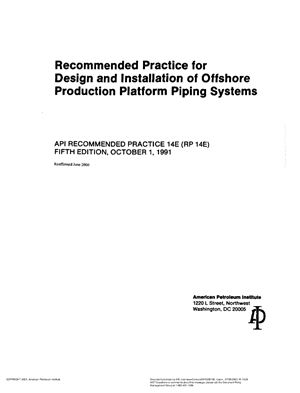American Petroleum Instltute (API) Fifth Edition, October. 1991.
Reaffirmed June 2000. 62p. This document recommends minimum
requirements and guidelines for the design and installation of new
piping systems on production platforms located offshore
API RP 14E-1991 Recommended Practice for Design and Installation of Offshore Production Platform Piping Systems
Стандарт

- формат pdf
- размер 3.97 МБ
- добавлен 03 февраля 2012 г.

Смотрите также
API RP 14F-1999 Recommended Practice for Design and Installation of Electrical Systems for Fixed and Floating Offshore Petroleum Facilities for Unclassified and Class I, Division 1 and Division 2 Locations
Стандарт- формат pdf
- размер 979.25 КБ
- добавлен 07 февраля 2012 г.
American Petroleum Instltute (API) Fourth Edition, June 1999. 104p. This document recommends minimum requirements and guidelines for the design and installation of electrical systems on fixed and floating petroleum facilities located offshore
API RP 14FZ-2001 Recommended Practice for Design and Installation of Electrical Systems for Fixed and Floating Offshore Petroleum Facilities for Unclassified and Class I, Zone 0, Zone 1 and Zone 2 Locations
Стандарт- формат pdf
- размер 1.03 МБ
- добавлен 07 февраля 2012 г.
American Petroleum Instltute (API) First Edition, September 2006. 127p. This document recommends minimum requirements and guidelines for the design and installation of electrical systems on fixed and floating petroleum facilities located offshore when hazardous locations are classified as Zone 0, Zone 1, or Zone 2.
API RP 2D-2003 Operation and Maintenance of Offshore Cranes
Стандарт- формат pdf
- размер 944.77 КБ
- добавлен 02 февраля 2012 г.
American Petroleum Institute (API) Fifth Edition, June 2003. 54p. This Recommended Practice is intended to serve as a guide to crane owners and operators in developing operating and maintenance practices and procedures for use in the safe operation of pedestal-mounted revolving cranes on fixed or oating offshore platforms, jackup drilling rigs, semisubmersible drilling rigs and other types of mobile offshore drilling units (MODUs).
API RP 2FB-2006 Recommended Practice for the Design of Offshore Facilities Against Fire and Blast Loading
Стандарт- формат pdf
- размер 715.9 КБ
- добавлен 08 февраля 2012 г.
American Petroleum Institute (API) First Edition, April 2002. 76p. This document provides guidelines and recommended practice for the satisfactory design of offshore structures against fire and blast loading.
API RP 2FPS-2001 Recommended Practice for Planning, Designing, and Constructing Floating Production Systems
Стандарт- формат pdf
- размер 1.8 МБ
- добавлен 02 февраля 2012 г.
American Petroleum Institute (API) First Edition, March 2001. 99p. This Recommended Practice (RP) provides guidelines for design, fabrication, installation, inspection and operation of Floating Production Systems (FPSs).
API RP 2FPS-2001 Recommended Practice for Planning, Designing, and Constructing Floating Production Systems
- формат pdf
- размер 1.8 МБ
- добавлен 08 февраля 2012 г.
American Petroleum Institute (API) First Edition, March 2002. 99p. This Recommended Practice (RP) provides guidelines for design, fabrication, installation, inspection and operation of Floating Production Systems (FPSs). The basic function of a FPS is to receive hydrocarbons from the wellhead, process the hydrocarbons, and store and/or ofЯoad the product to a shuttle tanker or convey it to a pipeline system
API RP 520-2-2003 Sizing, Selection, and Installation of Pressure-Relieving Devices in Refineries Part II - Installation
Стандарт- формат pdf
- размер 539.41 КБ
- добавлен 06 февраля 2012 г.
American Petroleum Instltute (API) Fifth Edition, August 2003. 42p. This recommended practice covers methods of installation for pressure-relief devices for equipment that has a maximum allowable working pressure (MAWP) of 15 psig (1.03 bar g or 103 kPA) or greater
API RP 551-1993 Process Measurement Instrumentation
Стандарт- формат pdf
- размер 4.19 МБ
- добавлен 03 февраля 2012 г.
American Petroleum Instltute (API) First Edition, May 1991. 68p. The procedures for installation of the instruments covered in this recommended practice are based on experience with and evaluation of many installations.
API RP 578. Material Verification Program for New and Existing Alloy Piping Systems
Стандарт- формат pdf
- размер 216.3 КБ
- добавлен 26 января 2012 г.
The purpose of this recommended practice is to provide the guidelines for a material and quality assurance system to verify that the nominal composition of alloy components within the pressure envelope of a piping system is consistent with the selected or specified construction materials to minimize the potential for catastrophic release of toxic or hazardous liquids or vapors.
API RP 75-2004 Recommended Practice for Development of a Safety and Environmental Management Program for Offshore Operations and Facilities
Стандарт- формат pdf
- размер 280.14 КБ
- добавлен 06 февраля 2012 г.
American Petroleum Instltute (API) Third Edition, May 2004. 52p. This recommended practice is intended to assist in development of a management program designed to promote safety and environmental protection during the performance of offshore oil and gas and sulphur operations.
